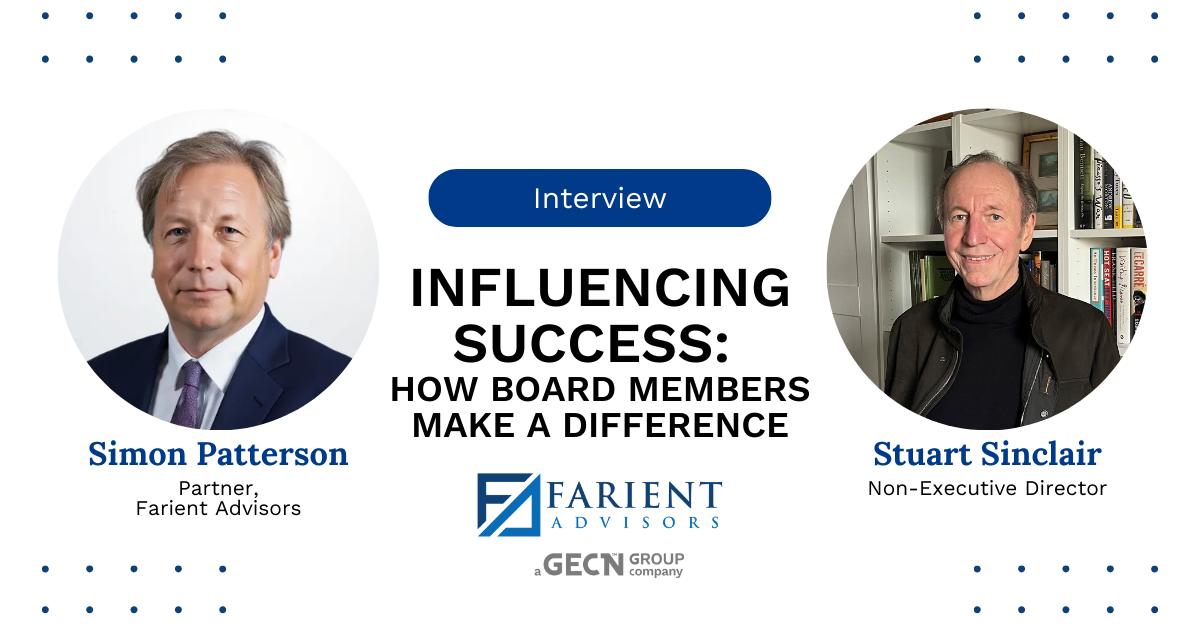Influencing Success: How Board Members Make a Difference
April 9, 2025
In our continuing series of one-on-one interviews with influential businesspeople in corporate governance, Farient Partner Simon Patterson recently caught up with Stuart Sinclair. In his executive career, Stuart has held management roles in banking, consulting, and insurance in the UK and internationally. He is the former CEO of Tesco Bank, CEO of GE Capital’s consumer business in the UK and China, and director of UK retail banking at RBS.
In his recent non-executive career, Stuart has served on 16 boards: listed and private, startup and mature, UK-based and overseas owned. Among his boards have been Lloyds Banking Group (the UK’s largest bank), LV Insurance, Willis Ltd, QBE (the Australian insurance company), Swinton insurance (owned by Covea in Paris), and several others. He recently became chair of Vida Bank, one of the UK’s new “challenger” banks. Stuart has been on and chaired several Remuneration Committees.

Simon: We’re here to talk about your real-life experience — why is that important?
Stuart: There are hundreds of business textbooks, but only a few are primarily experience-based. They tend to bypass the daily messiness, or even chaos, of a firm running hard. You aren’t trying to optimise a particular function, sale, or quarterly result but are thinking top down: What is critical? What can be ignored or safely delegated? What needs hourly or daily fretting? Most of what comes onto a CEO’s tray is noise, the genius is being able to spot what isn’t noise and train the larger guns on it.
I spent nine years as a CEO within GE Capital in London and Shanghai. GE’s approach was widely adopted, with 330,000 people sharing some basic appreciation of the merits of fact-based decision-making, process mapping, etc.
One of the accepted norms in GE was that if you wanted to survive the reasonably brutal evaluation steps and eventually become the CEO of an operating business, you needed to study to become a so-called Master Black Belt. That entailed two or three years of intermittent study, tests, interviews, and so forth to inculcate a way of thinking and assessing problems and opportunities. For example, GE’s credit card and aircraft engine businesses used the same vocabulary, charts, and tasks. That meant you could learn fast, and it underlined the importance of the factory and the “guy on the shop floor”.
Success also required exhibiting and demonstrating a set of values: being edgy, inclusive, and trying to get the best out of a mixed team of people. All of that was figured out 30 years ago so it’s surprising that some firms coming upon GE methods see them as a revelation. It’s always a bit embarrassing to say, “Oh, I’m familiar with that because I was exposed to it decades ago in GE.”
Simon: Mind-boggling.
Stuart: It never leaves you. It’s a kind of Bible you tend to carry with you.
Simon: You then went onto boards where you must arrive, figure out what’s what inside a company, how you can make a difference, and how your fellow board members can make a difference — specifically in the Remuneration Committee setting. How did you apply that?
Stuart: Well, being a non-executive director rather than an executive is entirely different. Many execs struggle when transitioning to a board. Their job is to listen, synthesize, periodically advise, and be more aware of the emotional forces at work in the boardroom. You need EQ as much as IQ. That’s the task when joining a board. Of course, you’re there to represent the interests of shareholders as a primary activity.
RemCo work can be fun. Many Directors fear that they’re ghastly and avoid being appointed to them. I’ve chaired several RemCos, including at some big companies. There is quite a lot of arcane detail that requires expertise, but the committee is not there just to have the detail rehearsed. It’s there to try and get the bigger picture and ask, for example: “What kinds of behaviours and outcomes do we want to reward in this company?”

Simon: Are external consultants useful?
Stuart: First, outside consultants can be useful because they can say, “I’ve been listening to your committee for an hour, and I have to say it’s very much in this mode, but other firms I advise see things differently. They’re considering different criteria. Shall we have a conversation about the gap? You decide. As an outsider, I’m just telling you that you are quite different from some of your peers. And you should be aware of that.”
Second, and I think this is a vital point, remuneration is far too important to be delegated to a Remuneration Committee. Yes, we must have them. Regulators expect to see them. There’s a lot of work to be done, but pay is way too important not to be a central topic for the main board. We’ve lost sight of that a bit, at least in Britain. We’ve delegated it. It’s become somewhat: “out of sight, out of mind.”
Simon: When I began working in the remuneration area, we simply answered this question: What are shareholders looking for? So, let’s pay executives to deliver that. It seemed sensible and made a tremendous difference to certain firms. When the 2008 financial crash happened, there was, inevitably, a tremendous amount of regulation that quelled decisions about how one would go about driving performance. Remuneration Committees became quite reticent about creativity. That’s a pity because incentive pay, as you say, is a weapon in the management armoury. It’s incredibly powerful for driving companies in certain directions. Companies that are growing fast need to pay people very differently than companies that are steady as they go.
Stuart: “What are shareholders looking for?” and “Let’s pay management to deliver that?” It’s almost that simple, isn’t it?
Simon: It was then. It’s complicated now.
Stuart: You’ve hit on a central and basic point that often has not been given enough honest attention. You ask a lot of companies how they know what their shareholders want. They’ll say, “Oh, we have investor relations people”. On one board, I attended at least 20 meetings one year because the investors’ governance team wanted to meet the RemCo chair. But in all those meetings, we never really got to the guts of why they held our shares. More importantly, when would they sell them or buy more? To a large extent, it was shadowboxing.
Simon: In preparation for this conversation, you mentioned the “daft laddie” question, a Scottish expression that means there’s no such thing as a dumb question. Can you explain what you mean by that?
Stuart: I think it’s an attitude that non-executive directors should foster, which is to say, just remind me, why are we even thinking about this? What problem are we trying to solve? One example from memory was a proposal for a “data lake.” It wasn’t a misconceived idea, but the daft laddie would ask, “Maybe that’s a solution in a year or so, but surely there are earlier tasks?” That’s a daft laddie question, which is to say, “Can we go back to basics?”

Simon: Boards are under tremendous performance pressure. What’s the best approach for greater productivity or perhaps more significant influence?
Stuart: First, select an unbalanced table. You want at least one awkward person predisposed to disagreement and even a bit of intolerance. Some of the most stressful, if ultimately fulfilling, moments have been when such a person is given free rein for a while. After all, you’re not here principally to agree. That may be the outcome if only by the chair imposing it, but you’re there to have the exec hear a raw and differentiated set of ideas they may not hear internally.
I remember one example. We were discussing whether to claw back a bonus and whether it should be a 20% or 25% haircut, and the ‘difficult’ director simply asked: “What does it take to get fired around here – what’s the outer limit here?”
Second, think hard about induction. When new board members arrive, how do you get the best out of them? I would write a first impressions memo for my fellow directors a few months after a new director joined us. Yes, it may have a lot of errors or misunderstandings, but it holds up a mirror to the board, which may have grown accustomed to one another’s foibles and pet topics and settled on a particular lens through which to see the board and evaluate roles.
A valuable part of a new NED’s induction is to ask them to think about two big-picture questions: First, what is the level of ambition of this firm relative to the opportunity? Is the bar set high enough? Indeed, is the opportunity fully defined and explored? And second, what is the match between the stated ambition and resources (principally, people and money)? This is not a bad starting point for early board discussions, highlighting how recently and thoroughly both management and NEDs visit the big picture.
Third, don’t be hesitant or shy about explicitly targeting board energy on particular subjects. This can benefit CEO/Chair bonding and help with board recruitment and induction. For instance, it’s fine to help the CEO on certain issues where the board or a board member can add value. The acquisitions area, for example. While there are governance norms to ensure the board is providing oversight, one can fine-tune its focus without feeling like it’s losing its essential independence. In this regard, a listed company board can periodically resemble the board dynamic in a P/E-owned firm.
Simon: That raises a good question: How should a board interact with management when setting performance goals? The Remuneration Committee doesn’t see pre-scrutinised or polished goals, for example. What should the process be?
Stuart: There are many ways to do this. The RemCo might do the initial heavy lifting of agreeing with management on the financial and non-financial performance parameters, plus agreeing on the weightings of these vis-a-vis some “values” parameters (reflecting how the results were achieved). These discussions can be illuminating, as it harks back to the firm’s purpose (why do we exist? What do we hope to achieve?) and what are the critical ingredients to achieving it (e.g. keeping a full product development pipeline, maintaining a rigorous management development process) as well as the more obvious outcome measures (like cash flow, net income, etc.) In some years, this discussion might be quite cursory (if the industry and the firm are steady), but in other years, some parts of this thought process may need reconstruction.
On this latter point, one of the most challenging questions is how a board or RemCo rewards management for the ability to adapt fast. That’s an area where a RemCo would want to hear a consultant’s point of view. The shareholders might want a different mix of outcomes, and regulators might change their minds on pay norms or ratios, and so on. We’ve all seen unexpected exogenous shocks like this come along. Once, the head of HR came to the RemCo meeting to say that if we go with the agreed-upon KPIs, 15 or 20 senior people get zero bonuses. Some said, “That’s life. You know, things happen.” Other people said, “Well, no. That’s not fair. They’ve worked very hard. They achieved everything we asked for. It’s just that the goalpost was moved.”
Simon: What did you decide?
Stuart: We ended up taking the hard route. Management cannot be untouched by changes in the environment. My point is there is always change. Plans go awry. That’s why people with expertise like yours exist.
Disclaimer: These views are his own and do not necessarily reflect those of his firms.
© 2025 Farient Advisors LLC. | Privacy Policy | Site by: Treacle Media